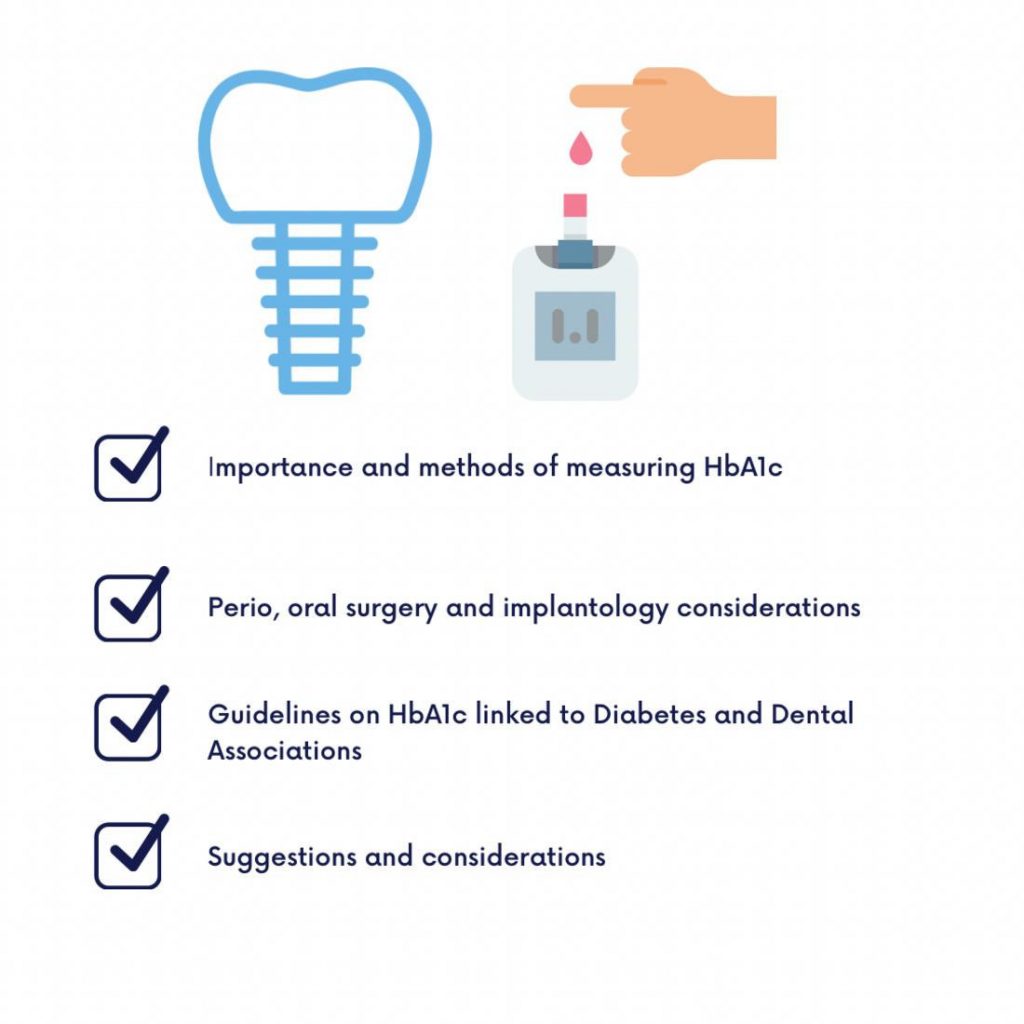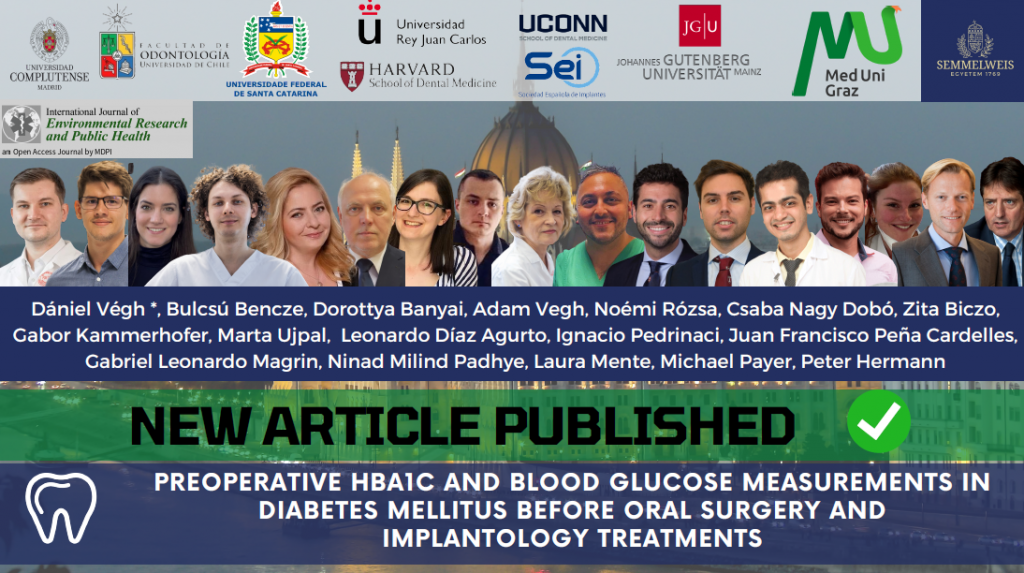It is well known that Diabetes Mellitus (DM) is a risk factor for dental implants, but what is the latest evidence and guidelines on the matter?
More than 500 million people live with this metabolic disease, and a large portion of people are still undiagnosed. Interestingly more people visit dentists (67.2%) than physicians (52.2%). Therefore, there is an excellent chance of encountering a patient with DM, either diagnosed or not, so up-to-date knowledge of diabetes care is invaluable for practicing dentists (Magliano & Boyko,2021; Mirza et al. 2018). This article aims to clarify some essential information on DM patient care by synthesizing the available guidelines and scientific papers to help in decision-making in some instances.
Most guidelines suggest “therapy targets” for glycemic levels based on the patient’s glycated hemoglobin level (HbA1c). This level shows the patient’s average blood glucose for the last 2-3 months; therefore, it holds precious information on the quality of glycemic control. If the patient’s DM is under control, then the disease has no significant repercussions on intraoral health (Diabetes Care, 2021; Mauri-Obradors et al. 2017).
There are two possibilities to determine the patient’s HbA1c level. The first option is conventional blood testing through laboratory analysis, but thankfully nowadays point-of-care devices are more widely available, which makes it possible to measure the patient’s HbA1c level with just a few drops of capillary blood right in the dental office. It is highly recommended to measure the patient’s HbA1c level in the treatment planning phase of dental implant placement.
The International Diabetes Foundation (IDF) and European Federation of Periodontology (EFP) held the Madrid consensus conference in 2017, a significant milestone in cooperation between diabetologists and periodontologists. This consensus conference created guidelines for patients, diabetologists and dentists. To avoid tooth loss, the critical message is straightforward: a regular dental visit can prevent long-term complications in the oral cavity for patients with DM (Sanz et al. 2018). Besides the scientific information, video content was also recorded in everyday language, so the lay audience could also understand the “to-do” list if experiencing some of the complications caused by DM.
There is a strong association between DM and peri-implant inflammation. A recent meta-analysis has shown that the risk of developing peri-implantitis is 50% higher in patients with DM than in systemically healthy individuals (Monje et al. 2017) The survival rate of dental implants in well-controlled diabetes patients ranges between 92.3-92.4%, which means that this procedure can be used safely and osseointegration does take place. Still, individual consideration is required for each patient, and providing antiseptic oral rinses and antibiotic treatment further improve the chance of success in the critical healing period (Singh et al. 2019; Wagner et al. 2022). Poorly controlled DM takes a heavy toll on implant stability, the decrease in implant stability at the time of surgical placement is significant when compared to well-controlled cases, and the time required for stability to return to baseline is almost double in such cases (Oates et al. 2009). Confirming the previously mentioned results, Wagner et al. found that patients with poorly controlled DM have a higher incidence rate of peri-implantitis and implant loss.
It is evident that measuring HbA1c is invaluable and that striving for a glycemic value in the well-controlled range is highly beneficial to the success of dental implants, but what exactly is the well-controlled range?
In 2021 the American Diabetes Association made a statement on glycemic targets and other suggestions. It is necessary to measure a patient’s HbA1c level at least twice a year in the case of reasonable control and quarterly in the case of poor control. Well-controlled glycemic status is considered to be under 7% HbA1c (53 mmol/mol) for most non-pregnant adults without significant hyperglycemia. Lower targets can be beneficial, but usually, this is only achievable without any adverse side effects if the patient has been recently diagnosed with DM. On the other hand, less stringent 8% goals can be set for patients if they have limited life expectancy or if the harm caused by strict glycemic control is greater than the benefit (Diabetes Care, 2021). The aforementioned targets can be adapted based on many personal attributes such as age, pregnancy, health and hemoglobin disorders.
In 2018 a consensus report was prepared by the ADA and the European Association for the Study of Diabetes where they agreed that for most non-pregnant adults with a high life expectancy, the goal of glycemic control is set around 7% Hba1c (53 mmol/ml) (Buse et al. 2020).
The Australian Diabetes Society has also issued a position statement where they set the limit for reasonable control at 7%, with the possibility of tightening it to 6% or relaxing it to 8% based on individual considerations (Cheung et al. 2009)
As we can see, according to the significant diabetes associations, an 8% HbA1c target can be applied to most patients, but what about dental associations?
There are some guidelines for glycemic control in dentistry, especially those that make suggestions related to dental implants. The American Academy of Periodontology and the European Federation of Periodontology have created a separate section for DM and glycemic control in their new classification of periodontal diseases. The grade of the patient’s periodontitis increases to “B” if the patient suffers from DM, but their HbA1c is below 7%. If it is above 7%, the grade is upgraded to a more severe “C” category (Tonetti & Sanz, 2019). More interestingly, The German Society of Dentistry and Oral Medicine (DGZMK) and the German Association of Implantology (DGI) have stated some significant glycemic targets in their implantology guidelines. They differentiate between three groups based on their glycemic control. Good control has an HbA1c value between 6-8%, moderate control between 8-10%, and finally, poor control is above 10% (Wiltfang, 2023) .
Overall, based on the available scientific evidence and guidelines, it is possible to suggest a glycemic target of 8% HbA1c for most patients with DM in order to avoid the possible adverse complications posed by this metabolic disease. We would like to emphasize the importance of HbA1c measurement, individual considerations, and co-operation between dentists and diabetologists.

Acknowledgements:
This research paper was a cooperation between 6 ITI Scholars (2021-2022) and their associates. Having six active ITI Scholars on a scientific paper is a world record, and with this action, we wanted to highlight the importance of scientific cooperation between ITI Scholars. During their ITI Scholarship year, they met several times and discussed the details of the information. An ITI Scholarship is a life-changing opportunity, and creating such cooperation and scientific papers will strengthen the community.
As an ITI Scholar, you get to learn from the best mentors in implantology and help create your research topics. However, socializing is also crucial; travel to ITI events to unite or reunite with your Scholarship fellows because during these meetings, with the help of the new connections, you can drive your career further and establish the connections that will help the ITI community grow in the future. If you are successful, you can become the new mentor generation of the ITI very soon, and will be able to give back to the community by mentoring and motivating the young generation of implant specialists.
Daniel Vegh has been living with type 1 DM since 2009. The idea for this paper came from him as part of his research interest. He leads the Semmelweis University Diabetes Dental Research Group and, together with his colleagues, he provides free oral screening for patients with DM. The other 5 ITI Scholars supported the evaluation of this paper. Statistically approximately every 10th patient has DM and we need a better understanding to provide the best care possible for our patients.
Daniel Vegh – Hungary
Ignacio Pedrinaci – Spain
Ninad Milind Padhye – India
Gabriel Leonardo Magrin – Brasil
Juan Francisco Peña Cardelles – Spain
Leonardo Díaz Agurto – Chile
If you need further information or cooperation proposals, please contact vegh.daniel@semmelweis.hu







